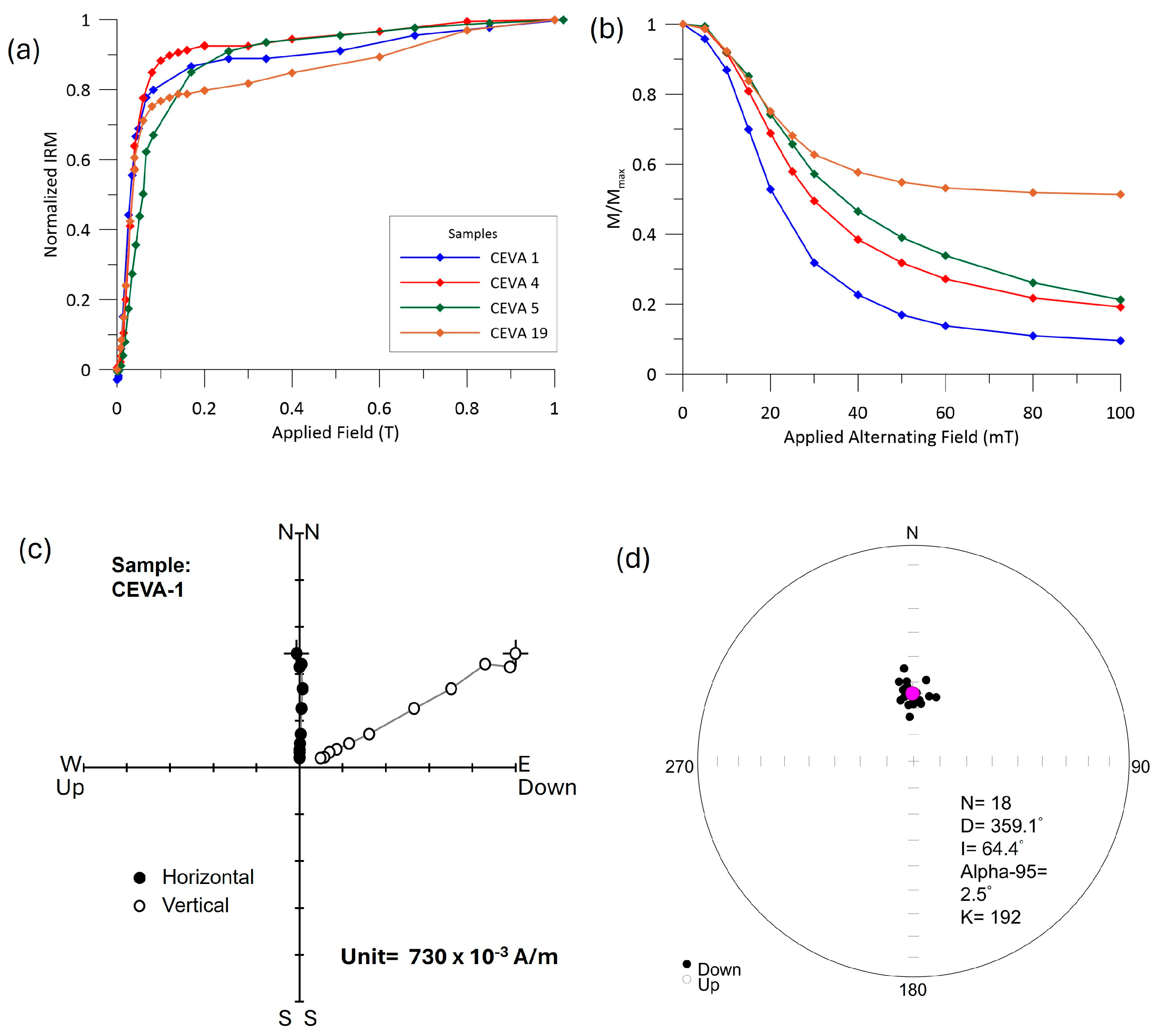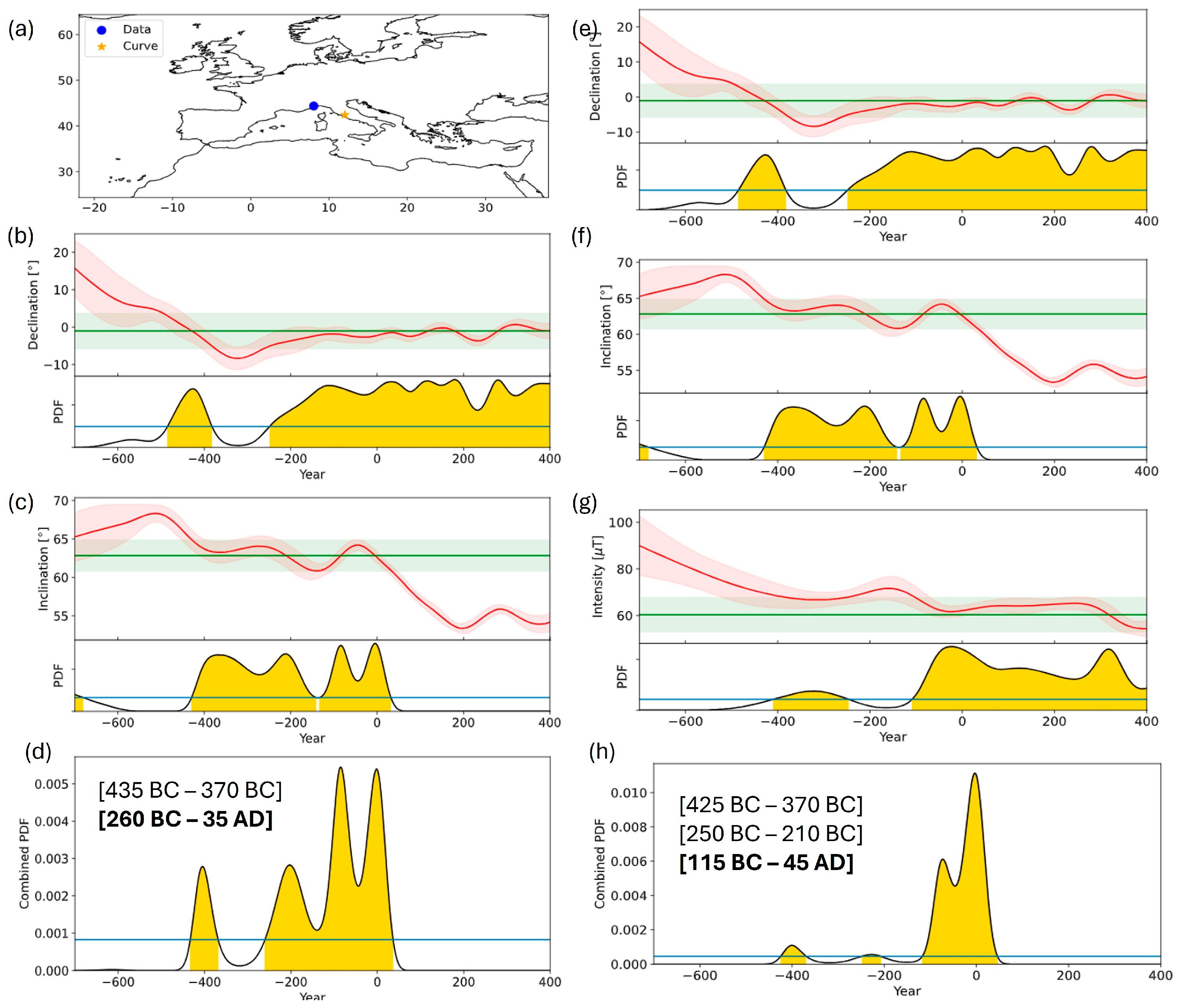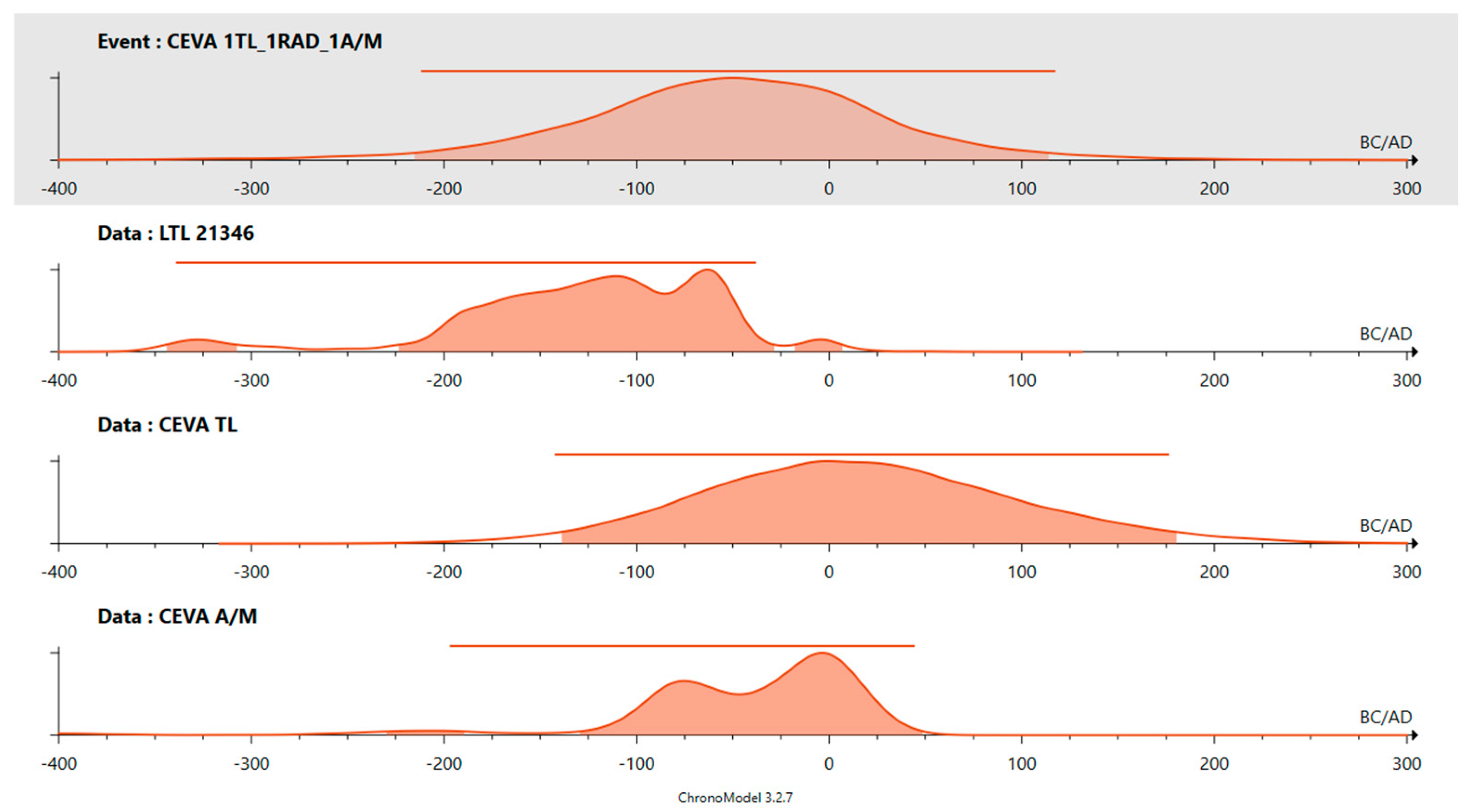Cross-Dating in Archaeology: A Comparative Archaeomagnetic, Thermoluminescence and Radiocarbon Dating of an Ancient Kiln, Ceva, Northern Italy
Abstract
1. Introduction
2. Materials and Methods
2.1. Archaeological Site and Sampling
2.2. Archaeomagnetic Analysis
2.3. Thermoluminescence Analysis
3. Results
3.1. Direction and Archaeointensity Determination
3.2. Archaeomagnetic Dating
3.3. Thermoluminescence Dating
4. Discussion and Conclusions
Supplementary Materials
Author Contributions
Funding
Data Availability Statement
Acknowledgments
Conflicts of Interest
References
- Tema, E.; Fantino, F.; Ferrara, E.; Lo Giudice, A.; Morales, J.; Goguitchaichvili, A.; Camps, P.; Barello, F.; Gulmini, M. Combined archaeomagnetic and thermoluminescence study of a brick kiln excavated at Fontanetto Po (Vercelli northern Italy). J. Archaeol. Sci. 2013, 40, 2025–2035. [Google Scholar] [CrossRef]
- Tema, E.; Fantino, F.; Ferrara, E.; Allegretti, S.; Lo Giudice, A.; Re, A.; Barello, F.; Vella, S.; Cirillo, L.; Gulmini, M. Archaeological archaeomagnetic and thermoluminescence investigation of a baked clay kiln excavated at Chieri, northern Italy: Contribution to the rescue of our cultural heritage. Ann. Geophys. 2014, 57, G0548. [Google Scholar] [CrossRef]
- Becker, H.; Göksu, H.Y.; Regulla, D.F. Combination of archaeomagnetism and thermoluminescence for precision dating. Quaternary Sci. Rev. 1994, 13, 563–567. [Google Scholar] [CrossRef]
- Batt, C. Archaeomagnetic Dating. In Handbook of Archaeological Sciences; Pollard, A.M., Armitage, R.A., Makarewicz, C.A., Eds.; Wiley: Hoboken, NJ, USA, 2023. [Google Scholar] [CrossRef]
- Aitken, M.J. Thermoluminescence Dating; Academic Press: London, UK, 1985. [Google Scholar]
- Aitken, M.J. Science-Based Dating in Archaeology; Longman Press House: London, UK; New York, NY, USA, 1990. [Google Scholar]
- Wagner, G.A. Age Determination of Young Rocks and Artifacts: Physical and Chemical Clocks in Quaternary Geology and Archaeology; Springer: Berlin/Heidelberg, Germany, 1998. [Google Scholar]
- Carrancho, Á.; Goguitchaichvili, A.; Morales, J.; Espinosa-Soto, J.A.; Villalaín, J.J.; Arsuaga, J.L.; Baquedano, E.; Pérez-González, A. Full-Vector Archaeomagnetic Dating of a Medieval Limekiln at Pinilla Del Valle Site (Madrid, Spain). Archaeometry 2017, 59, 373–394. [Google Scholar] [CrossRef]
- Principe, C.; Goguitchaichvili, A.; Devidze, M.; La Felice, S.; Cejudo, R.; Morales, J.; Cantini, F. Archaeomagnetic Dating of Three Furnaces inside the Middle Age Settlement of San Genesio (San Miniato Pisa, Italy). Land 2022, 11, 1936. [Google Scholar] [CrossRef]
- Tema, E.; Camps, P.; Ferrara, E.; Poidras, T. Directional results and absolute archaeointensity determination by the classical Thellier and the multispecimen DSC protocols for two kilns excavated at Osterietta Italy. Stud. Geophys. Geod. 2015, 59, 554–577. [Google Scholar] [CrossRef]
- Tema, E.; Polymeris, G.; Morales, J.; Goguitchaichvili, A.; Tsaknaki, V. Dating of ancient kilns: A combined archaeomagnetic and thermoluminescence analysis applied to a brick workshop at Kato Achaia, Greece. J. Cult. Herit. 2015, 16, 496–507. [Google Scholar] [CrossRef]
- Tema, E.; Ferrara, E.; Angelici, D.; Fantino, F.; Panero, E. The importance of multidisciplinary dating in rescue excavations: The case of Santhià Northern Italy. J. Archaeol. Sci. Rep. 2019, 28, 102059. [Google Scholar] [CrossRef]
- Kondopoulou, D.; Aidona, E.; Ioannidis, N.; Polymeris, G.S.; Tsolakis, S. Archaeomagnetic study and thermoluminescence dating of Protobyzantine kilns (Megali Kypsa, North Greece). J. Archaeol. Sci. Rep. 2015, 2, 156–168. [Google Scholar] [CrossRef]
- Aidona, E.; Polymeris, G.; Camps, P.; Kondopoulou, D.; Ioannidis, N.; Raptis, K. Archaeomagnetic versus Luminescence Methods: The case of an Early Byzantine Ceramic Workshop in Thessaloniki. Greece. Arch. Anthropol. Sci. 2018, 10, 725–741. [Google Scholar] [CrossRef]
- Lerma, S.G.; Casola, M.; Barello, F.; Tema, E. Ceva frazione Mollere, autostrada A6 Torino-Savona. Realizzazione area di sosta di Priero Sud. Fornace per laterizi di età romana. Quad. Archeol. Del Piemonte 2023, 7, 165–169. [Google Scholar]
- Cuomo Di Caprio, N. Proposta di classificazione delle fornaci per ceramica e laterizi nell’area italiana dalla preistoria a tutta l’epoca romana. Sibrium Cent. Studi Preist. Archeol. Varese Italy 1971–1972, 11, 371–464. [Google Scholar]
- Ferrero, L.; Giaretti, M.; Padovan, S. Gli abitati della Liguria interna: La ceramica domestica. In Ligures Celeberrimi, la Liguria Interna Nella Seconda età del Ferro: Atti del Convegno Internazionale (Mondovì, 26–28 Aprile 2002); Istituto Internazionale di Studi Liguri: Bordighera, Italy, 2004; pp. 51–80. [Google Scholar]
- Ferrero, L. Insediamenti e popolamento dell’Ager di Augusta Bagiennorum dall’età del Ferro ai primi secoli dell’Impero. In Augusta Bagiennorum. Storia e Archeologia di una Città Augustea; CELID: Torino, Italy, 2014; pp. 39–59. [Google Scholar]
- Negro Ponzi Mancini M., M. Strade e insediamenti nel cuneese dall’età romana al Medioevo: Materiali per lo studio della struttura del territorio. Boll. Soc. St. Stor. Arch. ed Art. Prov. Cuneo 1981, 85, 8–84. [Google Scholar]
- Zijderveld, J. AC demagnetization of rocks: Analysis of results. In Methods in Paleomagnetism Collinson; Collinson, D.W., Creer, K.M., Runcorn, S.K., Eds.; Elsevier: New York, NY, USA, 1967; pp. 254–256. [Google Scholar]
- Chadima, M.; Hrouda, F. Remasoft 3.0 a user-friendly paleomagnetic data browser and analyzer. Trav. Geophys. 2006, XXVII, 20–21. [Google Scholar]
- Thellier, E.; Thellier, O. Sur l’intensité du champ magnétique terrestre dans le passé historique et géologique. Ann. Geophys. 1959, 15, 285–376. [Google Scholar]
- Coe, R.S.; Grommé, S.; Mankinen, A. Geomagnetic paleointensities from radiocarbon dated lava flows on Hawai and the question of the Pacific nondipole low. J. Geophys. Res. 1978, 83, 1740–1756. [Google Scholar] [CrossRef]
- Leonhardt, R.; Heunemann, C.; Krása, D. Analysing absolute paleointensity determinations: Acceptance criteria and the software Thelliertool4.0. Geochem. Geophys. Geosyst. 2004, 5. [Google Scholar] [CrossRef]
- Polymeris, G.S. Thermoluminescence as a Tool for Age Assessment and Palaeothermometry Studies of Baked Clayey Artefacts. In Ceramic Analysis: Laboratory Methods; Hein, I., Ed.; Cambridge Elements, Current Archaeological Tools and Techniques; Cambridge University Press: Cambridge, UK, 2025; Volume 2025. [Google Scholar]
- Zimmerman, D.W. Luminescence dating using fine grains from pottery. Archaeometry 1971, 13, 29–56. [Google Scholar] [CrossRef]
- Vieillevigne, E.; Guibert, P.; Bechtel, F. Luminescence chronology of the medieval citadel of Termez, Uzbekistan: TL dating of bricks masonries. J. Archeol. Sci. 2007, 34, 1402–1416. [Google Scholar] [CrossRef]
- Hossain, S.M.; De Corte, F.; Vandenberghe, D.; van den haute, P. A comparison of methods for the annual radiation dose determination in the luminescence dating of loess sediment. Nucl. Inst. Methods Phys. Res. A 2002, 490, 598–613. [Google Scholar] [CrossRef]
- Liritzis, I.; Vafiadou, A. Calibration aspects of thick source alpha counter ZnS system. Measurement 2012, 45, 1966–1980. [Google Scholar] [CrossRef]
- Liritzis, I.; Mavrikis, D.; Zacharias, N.; Sakalis, A.; Tsirliganis, N.; Polymeris, G.S. Potassium determinations using SEM, FAAS and XRF: Some experimental notes. Mediter. Archaeol. Archaeom. 2011, 11, 169–178. [Google Scholar]
- Liritzis, I.; Stamoulis, K.; Papachristodoulou, C.; Ioannides, K. A re-evaluation of radiation dose rate conversion factors. Mediterr. Arch. Archaeomet. 2013, 13, 1–15. [Google Scholar]
- Serrano, M.; Pavón-Carrasco, F.J.; Campuzano, S.A.; Osete, M.L. ArchaeoPyDating: A new user-friendly release for archaeomagnetic dating. Archaeometry 2024, 66, 1424–1437. [Google Scholar] [CrossRef]
- Tema, E.; Lanos, P. New Italian directional and intensity archaeomagnetic reference curves for the past 3000 years: Insights on secular variation and implications on dating. Archaeometry 2021, 63, 428–445. [Google Scholar] [CrossRef]
- Zacharias, N.; Buxeda i Garrigos, J.; Mommsen, H.; Schwedt, A.; Kilikoglou, V. Implications of burial alterations on luminescence dating of archaeological ceramics. J. Archaeol. Sci. 2005, 32, 49–57. [Google Scholar] [CrossRef]
- Casas, L.; Tema, E. Investigating the expected archaeomagnetic dating precision in Europe: A temporal and spatial analysis based on the SCHA.DIF.3K geomagnetic field model. J. Archaeol. Sci. 2019, 108, 104972. [Google Scholar] [CrossRef]
- Stuiver, M.; Polach, H.A. Discussion Reporting of 14C Data. Radiocarbon 1977, 19, 355–363. [Google Scholar] [CrossRef]
- Reimer, P.J.; Bard, E.; Bayliss, A.; Beck, J.W.; Blackwell, P.G.; Bronkamsey, C.; Buck, C.E.; Cheng, H.; Edwards, R.L.; Friedrich, M.; et al. IntCal13 and Marine13 radiocarbon age calibration curves 0–50,000 years cal BP. Radiocarbon 2013, 55, 1869–1887. [Google Scholar] [CrossRef]
- Lanos, P.; Philippe, A. Hierarchical Bayesian modeling for combining dates in archeological context. J. Société Française Stat. 2017, 158, 17. [Google Scholar]
- Lanos, P.; Philippe, A. Event date model: A robust Bayesian tool for chronology building. Commun. Stat. Appl. Methods 2018, 25, 131–157. [Google Scholar] [CrossRef]
- Lanos, P.; Dufresne, P. Chronomodel Version 2.0: Software for Chronological Modelling of Archaeological Data Using Bayesian Statistics. 2019. Available online: http://www.chronomodel.com.






| Sample | U (ppm) | 232Th (ppm) | 40K (%) | ED (Gy) | ΔT (°C) | DR (Gy/ka) | TL Age (ka) | TL Age (yrs BC) |
|---|---|---|---|---|---|---|---|---|
| CE2 | 7.01 ± 0.10 | 11.14 ± 0.19 | 0.89 ± 0.05 | 7.93 ± 0.33 | 125 ± 2 | 3.736 ± 0.257 | 2.120 ± 0.203 | 98 ± 203 |
| CE5 | 7.44 ± 0.11 | 12.18 ± 0.15 | 0.95 ± 0.06 | 8.36 ± 0.32 | 108 ± 2 | 3.989 ± 0.231 | 2.095 ± 0.198 | 71 ± 198 |
| CE20 | 7.22 ± 0.11 | 11.44 ± 0.13 | 0.97 ± 0.05 | 8.04 ± 0.29 | 114 ± 2 | 3.893 ± 0.212 | 2.066 ± 0.206 | 41 ± 206 |
Disclaimer/Publisher’s Note: The statements, opinions and data contained in all publications are solely those of the individual author(s) and contributor(s) and not of MDPI and/or the editor(s). MDPI and/or the editor(s) disclaim responsibility for any injury to people or property resulting from any ideas, methods, instructions or products referred to in the content. |
© 2025 by the authors. Licensee MDPI, Basel, Switzerland. This article is an open access article distributed under the terms and conditions of the Creative Commons Attribution (CC BY) license (https://creativecommons.org/licenses/by/4.0/).
Share and Cite
Tema, E.; Polymeris, G.S.; Casola, M.; Lerma, S.G. Cross-Dating in Archaeology: A Comparative Archaeomagnetic, Thermoluminescence and Radiocarbon Dating of an Ancient Kiln, Ceva, Northern Italy. Heritage 2025, 8, 358. https://doi.org/10.3390/heritage8090358
Tema E, Polymeris GS, Casola M, Lerma SG. Cross-Dating in Archaeology: A Comparative Archaeomagnetic, Thermoluminescence and Radiocarbon Dating of an Ancient Kiln, Ceva, Northern Italy. Heritage. 2025; 8(9):358. https://doi.org/10.3390/heritage8090358
Chicago/Turabian StyleTema, Evdokia, Georgios S. Polymeris, Marco Casola, and Simone Giovanni Lerma. 2025. "Cross-Dating in Archaeology: A Comparative Archaeomagnetic, Thermoluminescence and Radiocarbon Dating of an Ancient Kiln, Ceva, Northern Italy" Heritage 8, no. 9: 358. https://doi.org/10.3390/heritage8090358
APA StyleTema, E., Polymeris, G. S., Casola, M., & Lerma, S. G. (2025). Cross-Dating in Archaeology: A Comparative Archaeomagnetic, Thermoluminescence and Radiocarbon Dating of an Ancient Kiln, Ceva, Northern Italy. Heritage, 8(9), 358. https://doi.org/10.3390/heritage8090358






